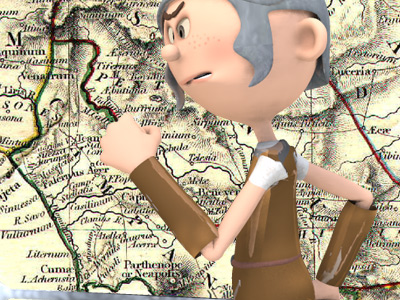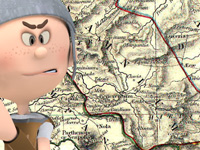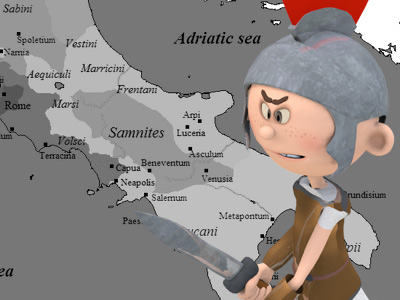Third Samnite War (298-290 BC)

298 BC Conflicting Accounts
According to Livy, the consul Lucius Cornelius Scipio Barbatus was assigned Etruria and his colleague Gnaeus Fulvius Maximus Centumalus was given the Samnites. Barbatus was engaged in a battle near Volterrae (in northern Etruria) which was interrupted by sunset. The Etruscans retreated during the night. Barbatus marched to the Faliscan district and laid Etruscan territory north of the River Tiber to waste. Gnaeus Fulvius won in Samnium and seized Bovianum, and Aufidena. However, an epitaph on the sarcophagus of Cornelius Scipio says that he ‘was consul, censor and aedile ...[and]... He captured Taurasia and Cisauna in Samnium; he subdued all Lucania and brought back hostages.’ Cornell says that the original inscription was erased and replaced by the extant one probably around 200 BC, and notes that this "was the period when the first histories of Rome were being written, which is not a coincidence.".
In addition to having Barbatus fighting in Samnium the inscription records him as taking Taurasia (probably in the Tammaro valley in the modern province of Benevento) and Cisauna (unknown location), rather than Bovianum and Aufidena. There is the further complication by the Fasti Triumphales (a record of Roman The Roman Republic was a form of government of Rome and the era of the classical Roman civilization when it was run through public representation of the Roman people. Beginning with the overthrow of the Roman Kingdom (traditionally dated to 509 BC) and ending in 27 BC with the establishment of the Roman Empire, Rome's control rapidly expanded during this period - from the city's immediate surroundings to hegemony over the entire Mediterranean world. triumphal celebrations), recording Gnaeus Fulvius’ triumphs against both the Samnites and the Etruscans. Forsythe points out that the consulship is the only public office Barbatus is mentioned as having held which gave him command of a legion. Modern historians have proposed various alternative scenarios wherein one or both of the consuls campaigned against both the Samnites and Etruscans, but without satisfactory conclusions. Cornell says that such an assumption could reconcile the sources, but "if so, neither Livy nor the inscription would emerge with much credit. Once again the evidence seems to show that there was a great deal of confusion in the tradition about the distribution of consular commands in the Samnite Wars, and that many different versions proliferated in the Late Republic." His conclusion is that "no satisfactory resolution to this puzzle is possible".
The Roman Republic was a form of government of Rome and the era of the classical Roman civilization when it was run through public representation of the Roman people. Beginning with the overthrow of the Roman Kingdom (traditionally dated to 509 BC) and ending in 27 BC with the establishment of the Roman Empire, Rome's control rapidly expanded during this period - from the city's immediate surroundings to hegemony over the entire Mediterranean world. triumphal celebrations), recording Gnaeus Fulvius’ triumphs against both the Samnites and the Etruscans. Forsythe points out that the consulship is the only public office Barbatus is mentioned as having held which gave him command of a legion. Modern historians have proposed various alternative scenarios wherein one or both of the consuls campaigned against both the Samnites and Etruscans, but without satisfactory conclusions. Cornell says that such an assumption could reconcile the sources, but "if so, neither Livy nor the inscription would emerge with much credit. Once again the evidence seems to show that there was a great deal of confusion in the tradition about the distribution of consular commands in the Samnite Wars, and that many different versions proliferated in the Late Republic." His conclusion is that "no satisfactory resolution to this puzzle is possible".
Regarding the submission of Lucania and the bringing back of hostages, Livy said that the Lucanians were willing to give hostages as a pledge of good faith. Cornell remarks that "[t]he intimation of that the Lucanians’ submission was the result of military action is a good example of how events could be improved in the telling." Forsythe points out that Livy noted that in 296 BC the Romans suppressed plebeian disturbances in Lucania on the behest of the Lucanian aristocracy. He argues that this suggests divisions in Lucania over the alliance with Rome and that, if this was also the case in 298 BC, Barbatus might have gone to Lucania to quell any possible local resistance to the alliance as well as to prevent Samnite raids and to collect the agreed hostages. Forsythe also notes that Barbatus’ campaign in Etruria could be explained in three ways: 1) it could be fictive; 2) Barbatus could have campaigned in both Samnium and Etruria; 3) Barbatus participated in the campaigns linked to the front which led to the Battle of Sentinum in 295 BC, and that this may have included operations in Etruria in that year, but it might have been attributed by later historians to his consulship in 298 BC. As for the claim that Barbatus subdued all of Lucania, Forsythe suggests that this is "perhaps part truth and part a Roman aristocratic exaggeration."
Oakley also points to two more problems with the sources. In Livy’s account, Bovianum, the capital of the Pentri, the largest of the four Samnite tribes, was captured in the first year of the war, which seems unlikely. Frontinus records three stratagems employed by one "Fulvius Nobilior" while fighting against the Samnites in Lucania. The cognomen Nobilior is not otherwise recorded before 255 BC, forty-five years after the end of the Samnite Wars. A plausible explanation is therefore that Nobilior is a mistake and the stratagems should be attributed to the consul of 298 BC.
HISTORY

RESOURCES
This article uses material from the Wikipedia article "Samnite Wars", which is released under the Creative Commons Attribution-Share-Alike License 3.0.
© Stories Preschool. All Rights Reserved.











